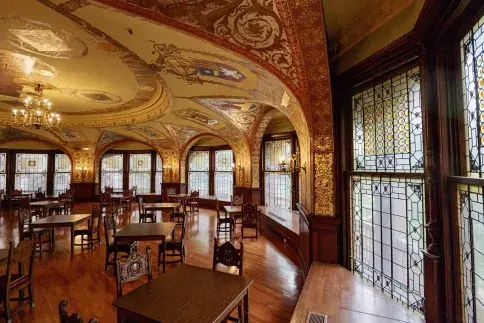Look Up
Decoding D-Hall: Ocean Lore

In the central part of the dining hall, there is so much to catch your eye. But a glance only skims the surface. Dive deeper with these fun facts!
Mermaid and Maidens
Mermaid and Maidens
Above the minstrel balconies (the wood curved “stage” areas above the doorways) at the entrance and before the food lines, it’s hard to miss the mermaids and maidens playing instruments.
These aren’t simply pretty women. They are a reference to sirens of Greek legend, the mythological creatures who used magic to lure sailors--a fitting allusion for a hotel that was all about luxury and escape near the sea.
This section of the mural, and many others, uses arabesque patterns which are derived from Greek art and have spread in popularity and style throughout history. An arabesque is a design that intertwines foliage, ribbons, and other elements in a scrolling, decorative pattern. This one has a nautical twist to complement the mermaids.
Between the women on each side is an ornate circle that hold the dates 1885-1887. These dates refer to the planning and construction dates of the Ponce de Leon Hotel.
A Good Luck Fish?
A Good Luck Fish?
In seemingly random places, you can look up and see sea creatures like fish and crabs. Notably in the corners of the walls in the middle of the dining hall below the ships of discovery.
In the 1600s, lobsters and shellfish represented wealth, luxury, and even sensuality. Fish, on the other hand, have long been associated with good luck and abundance, particularly in Roman mosaics. By including these creatures, the artists continued to weave the idea of the ocean as a source of fortune, a fitting message for a place meant to feel like paradise!
How many sea creatures can you find swimming (or crawling) our walls?